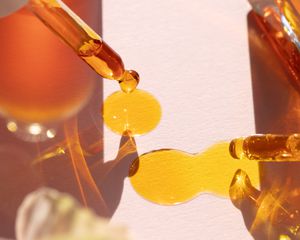
Byrdie / Cristina Cianci
Look, if something burns you bad enough—an ex, a curling iron, an all-natural shampoo that only made your hair greasier—then you'll likely keep your distance. It makes sense. The same might go for facial oils if you're prone to acne and perpetually slick with grease. (Take it from someone who knows firsthand.) Layering more oil to an already slippery face? It just doesn't sound like a good idea, and according to the experts (like celebrity esthetician Renée Rouleau), it usually isn't. Unless, of course, you have some strategy up your sleeves.
People with dry skin may have a lesser tendency to get breakouts. Plus, with the ever-popular term "oil-free" be-decking virtually every product that's not, well, an oil, that just adds fear-filled fuel to the fire, further enforcing the impression oils are the skincare equivalent of the devil. But of course, just because someone may have oily skin doesn't mean they should skimp on moisturizing altogether. In fact, that might just make matter worse. The key, as it turns out, is knowing which formulas to use to moisturize (generally your serums and creams) and which formulas can come in handy to lock in said hydration (ah, here's where oils can come into the mix.)
"I don't believe there are necessarily safe versus unsafe oils when it comes to acne, because every person's skin is unique, and what works well for one person may not work well for another," Rouleau tells me. "I believe the focus should not be on good or bad oils, but rather how they are used."
Curious to know how, when, and why you should use particular facial oils if you have acne? And, which types of oils get the green light from industry experts? Keep reading—glowy, pimple-free complexions await.
How to Pick the Best Facial Oils for Acne
According to Rouleau, if you're going to use an oil while dealing with oily or acne-prone skin, the best thing you can do is find a formula that boasts other benefits for your skin—for instance, one that features lots and lots of antioxidants. Essentially, look for oils that boast an ingredient list chock-full of vitamins like A, C, beta-carotene, etc., which will further enforce skin health with a barrier of antioxidants.
"All skin types, even those with acne, will benefit from antioxidants. My Pro Remedy Oil ($69) uses both antioxidants and a blend of 12 lipid-rich oils to give exceptional barrier repair," explains Rouleau.
Key Ingredients
Lipids are the skin's natural fats. They help strengthen the skin’s protective barrier and aid its natural repair process.
The Right Way to Apply Them
Rouleau feels strongly about technique. "In the evening after cleansing, toning with an alcohol-free toner (left damp on the skin for extra hydration) and using a serum followed with moisturizer, pat (do not massage) one to three drops of oil onto the skin," she says. (She also recommends rubbing the oil in your hands to disperse it a bit prior to patting it on.)
To stay hydrated, Rouleau explains, oily skin craves water to maintain healthy moisture levels—not more oil. Moisturizers, she explains, are typically lightweight and free of oils, so they're the more strategic way to add hydration to greasy or acne-prone skin. This lightweight elixir is what you want to hit the skin with first to maximize absorption, and then after the fact, you can lightly seal in the moisturizer with a facial oil, which will add what Rouleau describes as a "protective layer" to your skin's moisture barrier. Just make sure to be light-handed and use her aforementioned patting method.
"A patting method allows it to really stay on the very top of the skin so only your lighter moisturizer is truly coming into direct contact with the pores. Think of an oil as being a topcoat. A toner is a base coat, a serum and moisturizer are like the two layers of nail polish, and the oil is a topcoat," she explains. "The real benefit of a facial oil comes from its ability to act as a sealant and to help all the water-binding products underneath to work most efficiently."
The Wrong Way to Apply Them
According to Rouleau, what you most definitely don't want to do if you're broken out or prone to acne is mix a facial oil directly into your moisturizer/lotion (as it's easy to overdo it) or massage it directly on the skin in lieu of a lightweight moisturizer.
Again, oily skin requires water for hydration, not more oil. When skin is broken out or prone to blemishes, Rouleau tells me, oil is far more likely to breed bacteria, which ultimately comes full circle—exacerbating and/or instigating unwanted bumps and pimples. If you find that a skin oil is causing bumps or increased breakouts, then discontinue use.
The Best Times to Use Facial Oils If You Have Acne
"Treatment oils can be incredibly effective for most skin types, but the way in which the oil is applied to the skin will vary depending on your skin type. In general, I recommend using oils in the evening, as this is when the skin is at rest (and the air is usually driest at night) so the oil can repair and protect your skin while you sleep," says Rouleau. But again, proceed with caution, and if you suspect an oil is leading to bumps and breakouts, nix it immediately. (Also, avoid clog-prone, comedogenic oils like coconut oil—eek.)
That being said, Rouleau suggests (lighthandedly) experimenting with oils at certain critical times when even acne-prone skin might be especially susceptible to dehydration—like flying on an airplane (hello, water loss) if the skin's barrier has been compromised from harsh acne prescriptions or over-exfoliating, or during the winter months when humidity has made its seasonal exit.


























